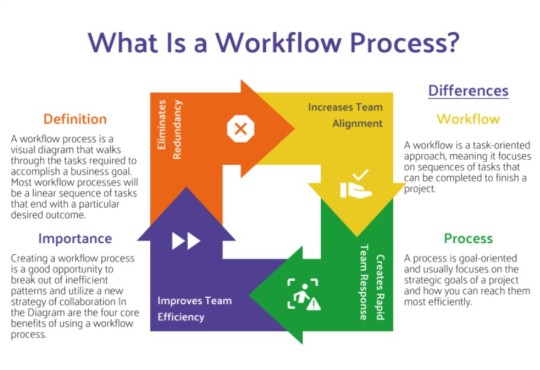#Resource Capacity Planning Software
Explore tagged Tumblr posts
Text
10 Best Resource Capacity Planning Software of 2023
Resource capacity planning software is a tool that helps organizations to manage their resources effectively by providing a way to estimate, allocate, and track the availability and usage of resources such as personnel, equipment, and facilities.
This software typically includes features such as resource scheduling, workload management, forecasting, and reporting. It can help organizations to optimize resource utilization, avoid overloading resources, and identify resource gaps or constraints that may impact project timelines or budgets.
Resource capacity planning software can be used in various industries, such as construction, manufacturing, healthcare, IT, and professional services. It can be particularly useful for large or complex projects that involve multiple teams, stakeholders, and resources.
1 note
·
View note
Text
How to Build a Work Breakdown Structure? A Step-by-Step Guide
A work breakdown structure divides the project into smaller components in a hierarchical manner to ensure tasks are completed sequentially and on time.
Read this blog to know more: https://bit.ly/4gFQxIG
#resource capacity planning#saviom#resource management#software#resource management software#resourceoptimization
0 notes
Text

Updated B-52 electronic warfare suite will be tested in flight in 2024
Fernando Valduga By Fernando Valduga 03/29/2024 - 10:36 in Military
Flying through the skies since the 1950s, the B-52 Stratofortress is a U.S. Air Force (USAF) workhorse and a lasting symbol of American military power. The eight-engine giant has unique capabilities unparalleled to any other American warplane - which is why, after more than 70 years of service, it continues to play a vital role in the defense and national security strategy of the U.S. And thanks to a collaboration between L3Harris and USAF, this iconic aircraft is prepared to remain ready for the mission against highly sophisticated emerging threats in the coming decades.
Under a 10-year contract worth $947 million granted in 2021, L3Harris is upgrading and improving the AN/ALQ-172 electronic war self-protection system (EW), which protects the B-52 and air crews from a wide range of electronic threats. Our current work is based on decades of experience in providing critical technology as a Manufacturer of Original Equipment of the AN/ALQ-172 systems for the B-52 fleet. And combined with other ongoing modernization efforts, these updates will increase the relevance and reliability of the B-52 by the 2050s.

L3 Harris AN/ALQ-172 systems.
"Our opponents continue to evolve, facing advanced and far-reaching threats that challenge our ability to operate in contested environments," says Robert "Trip" Raymond, USAF's Program Leader for EW Technology Development at L3Harris. "It is essential that we provide our B-52 crew with the necessary tools to keep the B-52 relevant, lethal and survivable as the backbone of the strategic bomber force of the United States."
The effort of modernization and support - ALQ-172 Maintenance and Reliability System (MARS) - intends to do exactly that, increasing the average time between failures due to its modular design, while further improving the performance, maintenance capacity and reliability of the system. Thanks to an integrated and improved radio frequency system, crews will be able to simultaneously combat multiple radar threats that interfere with aircraft operations. And by replacing analog systems with more economical software solutions, USAF will be able to reduce the size of B-52 crews from 5 to 4. This frees up resources for additional mission-critical activities.
Ultimately, the updates will further help USAF in its Global Attack Mission and strengthen the effectiveness of the B-52 in modern warfare, while making future upgrades cheaper and easier.
"We are implementing affordable solutions that not only reduce costs, but also provide crews with more advanced protection against the most sophisticated threats detected by radar," said Jimmy Mercado, Program Director at L3Harris. "All this results in a more modern, efficient and effective aircraft, ready to dominate the future struggle."
USAF plans to conduct a test flight with the new electronic warfare capabilities of the B-52 in 2024.
Tags: Military AviationBoeing B-52H StratofortressEW - ELECTRONIC WARL3HarrisUSAF - United States Air Force / U.S. Air Force
Sharing
tweet
Fernando Valduga
Fernando Valduga
Aviation photographer and pilot since 1992, he has participated in several events and air operations, such as Cruzex, AirVenture, Dayton Airshow and FIDAE. He has works published in specialized aviation magazines in Brazil and abroad. He uses Canon equipment during his photographic work in the world of aviation.
Related news
AERONAUTICAL ACCIDENTS
VIDEO: Russian Su-27 fighter in flames falls into the sea near Sevastopol
29/03/2024 - 09:43
An F-16 fighter from the Norwegian air force lands at a Turkish air base in the Turkish city of Konya, in Central Anatolia. Norway, a member of NATO, will donate F-16 fighters to Ukraine, whose forces are involved in a difficult counter-offensive against Russia. (Photo: AP / Burhan Ozbilici)
MILITARY
Putin threatens to attack NATO air bases that host Ukrainian F-16 fighters
28/03/2024 - 21:56
MILITARY
Retirement from F-22 in 2030 is unlikely, since USAF intends to spend $7.8 billion on it before that
28/03/2024 - 21:16
MILITARY
IMAGES: Inaugural flight of the first light combat aircraft Tejas Mk 1A
28/03/2024 - 18:27
Dassault Rafale Fighter. (Photo: Katsuhiko Tokunaga)
MILITARY
France tests Thales' IRST system update for Rafale F4.2 update
28/03/2024 - 15:00
MILITARY
Dutch drone fleet MQ-9A Reaper will receive tactical updates
28/03/2024 - 14:00
37 notes
·
View notes
Text

Bethesda Softworks will close Redfall developer Arkane Austin, Hi-Fi RUSH and The Evil Within developer Tango Gameworks, as well as Alpha Dog Games and Roundhouse Studios, according to a companywide email sent out by Microsoft Gaming president of game content and studios Matt Booty this morning.
Full email
Today I’m sharing changes we are making to our Bethesda and ZeniMax teams. These changes are grounded in prioritizing high-impact titles and further investing in Bethesda’s portfolio of blockbuster games and beloved worlds which you have nurtured over many decades.
To double down on these franchises and invest to build new ones requires us to look across the business to identify the opportunities that are best positioned for success. This reprioritization of titles and resources means a few teams will be realigned to others and that some of our colleagues will be leaving us.
Here are the changes going into effect:
Arkane Austin – This studio will close with some members of the team joining other studios to work on projects across Bethesda. Arkane Austin has a history of making impactful and innovative games and it is a pedigree that everyone should be proud of. Redfall‘s previous update will be its last as we end all development on the game. The game and its servers will remain online for players to enjoy and we will provide make-good offers to players who purchased the “Hero” downloadable content.
Alpha Dog Studios – This studio will also close. We appreciate the team’s creativity in bringing DOOM to new players. Mighty DOOM will be sunset on August 7 and we will be turning off the ability for players to make any purchases in the game.
Tango Gameworks – Tango Gameworks will also close. We are thankful for their contributions to Bethesda and players around the world. Hi-Fi RUSH will continue to be available to players on the platforms it is today.
Roundhouse Games – The team at Roundhouse Games will be joining ZeniMax Online Studios (ZOS). Roundhouse has played a key role in many of our recent game launches and bringing them into ZOS to work on The Elder Scrolls Online will mean we can do even more to grow the world that millions of players call home.
With this consolidation of our Bethesda studio teams, so that we can invest more deeply in our portfolio of games and new IP, a small number of roles across select Bethesda publishing and corporate teams will also be eliminated.
Those whose roles will be impacted will be notified today, and we ask that you please treat your departing colleagues with respect and compassion. We will provide our full support to those who are impacted in today’s notifications and through their transitions, including severance benefits informed by local laws.
These changes are not a reflection of the creativity and skill of the talented individuals at these teams or the risks they took to try new things. I acknowledge that these changes are also disruptive to the various support teams across ZeniMax and Bethesda that bring our games to market. We are making these tough decisions to create capacity to increase investment in other parts of our portfolio and focus on our priority games.
Bethesda remains one of the key pillars of Xbox with a strong portfolio of amazing games and thriving communities. As we look to the future, there is an impressive line-up of games on the horizon. In 2024 alone we have Starfield “Shattered Space,” Fallout 76 “Skyline Valley,” Indiana Jones and The Great Circle, and The Elder Scrolls Online‘s “Golden Road.” As we align our plans and resources to best set ourselves up for success in this complex and changing industry, our teams across Arkane Lyon, Bethesda Game Studios, id Software, MachineGames, ZeniMax Online Studios, and the Bethesda publishing and corporate teams will be well-positioned to build new IP, explore new game concepts, and expand on our existing franchises.
—Matt
Messages from each studio
Arkane Austin

Tango Gameworks

Alpha Dog Games

#Microsoft#Zenimax Media#Bethesda Softworks#Arkane Austin#Tango Gameworks#Alpha Dog Games#Roundhouse Studios#Zenimax Online Studios#Redfall#Hi Fi Rush#The Evil Within#Ghostwire Tokyo#video game#Xbox Series#Xbox Series S#Xbox Series X#PC
32 notes
·
View notes
Text

How to manage a company's workflow?
Managing workflow in a company ensures efficiency and productivity. Here are key steps:
1. Define Clear Processes and Procedures
Document Workflows: Outline each step and develop Standard Operating Procedures (SOPs).
2. Assign Roles and Responsibilities
Role Clarity: Ensure team members understand their roles and tasks.
3. Utilize Workflow Management Tools
Project Management Software: Use tools like Trello or Asana.
Automation: Implement automation for repetitive tasks.
4. Set Clear Goals and Priorities
SMART Goals: Define Specific, Measurable, Achievable, Relevant, and Time-bound goals.
Prioritization: Focus on high-priority tasks.
5. Monitor and Measure Performance
KPIs and Metrics: Establish Key Performance Indicators.
Regular Reviews: Conduct performance reviews to identify bottlenecks.
6. Foster Communication and Collaboration
Communication Tools: Use Slack or Microsoft Teams.
Regular Meetings: Hold team meetings for updates and discussions.
7. Continuously Improve Processes
Feedback: Encourage employee feedback.
Optimization: Regularly review and update workflows.
8. Manage Resources Efficiently
Resource Allocation: Allocate resources effectively.
Capacity Planning: Plan resource needs in advance.
9. Ensure Training and Development
Skill Development: Provide ongoing training.
Knowledge Sharing: Encourage knowledge sharing within the team.
10. Address Challenges Proactively
Problem-Solving: Quickly address issues.
Flexibility: Adapt workflows as needed.
Example Workflow Management Approach
Initiation: Identify tasks and assign a leader.
Planning: Break down tasks, assign them, and identify resources.
Execution: Perform tasks and monitor progress.
Monitoring and Controlling: Track progress, hold status meetings, and adjust plans.
Completion: Review tasks, gather feedback, and document lessons learned.
#advertising#artificial intelligence#autos#business#developers & startups#edtech#finance#education#futurism#marketing
19 notes
·
View notes
Text
Boosting Efficiency: The Role of ERP Software in Modern Manufacturing Operations
In today's fast-paced manufacturing landscape, efficiency is not just a desirable trait; it's a necessity. To stay competitive and meet the demands of the market, manufacturers must streamline their processes, optimize resource utilization, and enhance decision-making capabilities. This is where Enterprise Resource Planning (ERP) software steps in as a game-changer. In this article, we'll delve into the pivotal role of ERP systems in revolutionizing manufacturing operations, particularly in India's thriving industrial sector.

Understanding ERP for Manufacturing Industry
ERP systems for manufacturing are comprehensive software solutions designed to integrate and automate core business processes such as production planning, inventory management, supply chain logistics, financial management, and human resources. By consolidating data and operations into a unified platform, ERP empowers manufacturers with real-time insights, facilitates collaboration across departments, and enables informed decision-making.
Streamlining Operations with ERP Solutions
In the dynamic environment of manufacturing, where every minute counts, efficiency gains translate directly into cost savings and competitive advantages. ERP software for manufacturing offers a multitude of features that streamline operations and drive efficiency:
1. Enhanced Production Planning: ERP systems enable manufacturers to create accurate production schedules based on demand forecasts, resource availability, and production capacity. By optimizing production timelines and minimizing idle time, manufacturers can fulfill orders promptly and reduce lead times.
2. Inventory Management: Efficient inventory management is crucial for balancing supply and demand while minimizing holding costs. ERP software provides real-time visibility into inventory levels, automates reorder points, and facilitates inventory optimization to prevent stockouts and overstock situations.
3. Supply Chain Optimization: ERP solutions for manufacturing integrate supply chain processes from procurement to distribution, enabling seamless coordination with suppliers and distributors. By optimizing procurement cycles, minimizing transportation costs, and reducing lead times, manufacturers can enhance supply chain resilience and responsiveness.
4. Quality Control: Maintaining product quality is paramount in manufacturing to uphold brand reputation and customer satisfaction. ERP systems offer quality management modules that streamline inspection processes, track product defects, and facilitate corrective actions to ensure adherence to quality standards.
5. Financial Management: Effective financial management is essential for sustaining manufacturing operations and driving profitability. ERP software provides robust accounting modules that automate financial transactions, streamline budgeting and forecasting, and generate comprehensive financial reports for informed decision-making.
6. Human Resource Management: People are the cornerstone of manufacturing operations, and managing workforce efficiently is critical for productivity and employee satisfaction. ERP systems for manufacturing include HR modules that automate payroll processing, manage employee records, and facilitate workforce planning to align staffing levels with production demands.
The Advantages of ERP for Manufacturing Companies in India
India's manufacturing sector is undergoing rapid transformation, fueled by factors such as government initiatives like "Make in India," technological advancements, and globalization. In this dynamic landscape, ERP software plays a pivotal role in empowering manufacturing companies to thrive and remain competitive:
1. Scalability: ERP solutions for manufacturing are scalable, making them suitable for companies of all sizes – from small and medium enterprises (SMEs) to large conglomerates. Whether a company is expanding its operations or diversifying its product portfolio, ERP systems can adapt to evolving business needs and support growth.
2. Compliance: Regulatory compliance is a significant concern for manufacturing companies in India, given the complex regulatory environment. ERP software incorporates compliance features that ensure adherence to industry regulations, tax laws, and reporting requirements, minimizing the risk of non-compliance penalties.
3. Localization: ERP vendors catering to the Indian manufacturing sector offer localized solutions tailored to the unique requirements of the Indian market. From multi-currency support to GST compliance features, these ERP systems are equipped with functionalities that address the specific challenges faced by Indian manufacturers.
4. Cost Efficiency: Implementing ERP software for manufacturing entails upfront investment, but the long-term benefits far outweigh the costs. By streamlining processes, optimizing resource utilization, and reducing operational inefficiencies, ERP systems drive cost savings and improve overall profitability.
5. Competitive Edge: In a fiercely competitive market, manufacturing companies in India must differentiate themselves through operational excellence and agility. ERP software equips companies with the tools and insights needed to outperform competitors, adapt to market dynamics, and capitalize on emerging opportunities.
Choosing the Right ERP Software for Manufacturing
Selecting the right ERP solution is crucial for maximizing the benefits and ensuring a smooth implementation process. When evaluating ERP software for manufacturing, companies should consider the following factors:
1. Industry-specific functionality: Choose an ERP system that offers industry-specific features and functionalities tailored to the unique requirements of manufacturing operations.
2. Scalability and flexibility: Ensure that the ERP software can scale with your business and accommodate future growth and expansion.
3. Ease of integration: Look for ERP systems that seamlessly integrate with existing software applications, such as CRM systems, MES solutions, and IoT devices, to create a cohesive technology ecosystem.
4. User-friendliness: A user-friendly interface and intuitive navigation are essential for ensuring widespread adoption and maximizing user productivity.
5. Vendor support and expertise: Select a reputable ERP vendor with a proven track record of success in the manufacturing industry and robust customer support services.
Conclusion
In conclusion, ERP software has emerged as a cornerstone of modern manufacturing operations, empowering companies to enhance efficiency, drive growth, and maintain a competitive edge in the global market. For manufacturing companies in India, where agility, scalability, and compliance are paramount, implementing the right ERP solution can be a transformative investment that paves the way for sustainable success. By harnessing the power of ERP, manufacturers can optimize processes, streamline operations, and unlock new opportunities for innovation and growth in the dynamic landscape of the manufacturing industry.
#ERP software providers in India#Manufacturing enterprise resource planning#ERP systems for manufacturing companies#ERP system for manufacturing industry#ERP for manufacturing companies#ERP software for engineering company#ERP software for engineering companies in India#ERP software for engineering companies in Mumbai#ERP solution providers in India#ERP for manufacturing industry#ERP systems for manufacturing#ERP solutions for manufacturing#ERP software manufacturing industry#ERP for manufacturing company in India#India
8 notes
·
View notes
Text
Expanding Horizons: Exploring New Markets for Business Development
Article by Jonathan Bomser | CEO | AccountSend.com

As your business matures, tapping into new markets—be they niche industries, emerging markets, or even geographical expansion—can be a lucrative strategy for growth. If you're contemplating business expansion, here are seven key points to keep in mind.
DOWNLOAD THE NEW MARKETS INFOGRAPHIC HERE
Research and Understand the Market
Before diving into a new market, invest time and resources in thorough research. Understand the market dynamics, customer preferences, cultural nuances, and the competitive landscape. Tools like global business expansion databases and data analysis software can provide valuable insights.
Evaluate Your Business's Capabilities
Assess your business's capacity to handle expansion. This involves reviewing your financial health, operational capacity, and the adaptability of your products or services to the new market. Also, consider if your current team can manage the expansion or if additional hiring is needed.
Build a Targeted B2B Contact Database
Having a robust B2B contact database is crucial for successful market entry. Gather verified contact info, including email addresses and phone numbers, of decision-makers in the new market. Reputable B2B data providers can assist in building a comprehensive contact database.
Develop a Tailored Marketing Strategy
One size doesn't fit all when it comes to marketing strategies. What works in your existing market may not be effective in a new one. Develop a marketing strategy tailored to the preferences and needs of your new market. This might involve a shift in messaging, promotional channels, or even product positioning.
Leverage Partnerships
Forming strategic partnerships can help you establish a foothold in the new market. Look for potential partners that complement your business and can help you reach your target audience more effectively.

Manage Risks
Entering a new market involves risks. Financial risk, reputational risk, and operational risk are a few examples. Identify potential risks and devise strategies to mitigate them.
Measure and Adjust
Once you've launched in the new market, it's vital to track your progress, measure success, and make necessary adjustments. Use key performance indicators (KPIs) that are relevant to your objectives in the new market.
In conclusion, exploring new markets is an exciting venture that can yield significant benefits. However, it requires careful planning, strategic thinking, and ongoing measurement and adjustment. With the right approach, you can successfully navigate this journey and achieve your business development goals.
#AccountSend#B2BLeadGeneration#B2BLeads#B2BSales#B2BDatabase#LeadGeneration#ContactDatabase#BusinessLeads#B2BProspects#SalesLeads#SalesProspecting
21 notes
·
View notes
Text
📁 Interview 001: "Making Keitai Hakken" ft. snowsorry

"Developmental interview with snowsorry"
For the first interview of this blog, I decided to retrace my steps by revisiting the creation and development of the first sound source for the keitaiware project. I also plan to go over my goals and future plans concerning this project. For a short summary, the keitaiware project was launched in order to prepare beginner UTAU users with the materials they need to navigate the program on MacOS. As of right now, these resources are still being uploaded live, and I want to thank everyone for their support regarding the project thus far! I want to keep sharing tutorials and offering my best work from this point forward. I don't think I would have made it this far without the support of the friends I have made during my time here. Today we will be interviewing my friend snowsorry, the voice provider of Keitai Hakken. For this interview we will go over Hakken's development and the future developments regarding his sound source. I would like to note that, we are good friends and this might be a bit informal, but we are both very passionate about the direction of this project.
Before I ask any questions, I would like to summarize my original thoughts regarding the project. This project was launched because there is a great lack of resources regarding the field of MacOS UTAU. Prior to keitaiware, I would assist my friends with any technical difficulties but quickly realized half of what I was preforming was unsearchable. Originally, I wasn't planning to brand my tutorials, and had my eyes set on releasing tutorials in simplicity until I had jokingly designed Hakken back in February 16th 2024. Hakken was originally a gijinka character based on the MacOS Finder application, but has become his personal trademark. Occasionally running the gag of file organization and finite storage capacity. After designing him, I realized he could be the mascot for the UTAU resource blog, thus development began. In April I launched auditions with a very low turnout, but within that attempt I was able to find his voice and continue with the process! I would like to thank Colle for all his efforts and contributions towards the project, if not for people like him, I would not have been able to learn so much.
Q. For our first question I would like you to introduce yourself! How long have you been doing UTAU activities for, and how did you become familiar with the program?
Snowsorry: Hello! My name is Colle, but people typically know me by my username, "snowsorry". I consider myself to be a vocal synth cover artist who mainly works with UTAU. I only started doing UTAU/cover works a little over two years ago now. I had an interest in and followed Vocaloid music for a long time, so much so I can't pinpoint when that even started, but because of that I was very aware of the existence of UTAU-- however I hadn't really attempted to work with it until recent years. I don't really remember what exactly sparked me to pursue it…. I think it was because I was dabbling in MMD and wanted to play with the idea of my original characters singing the songs themselves. Really, I just remember going, "I'm going to make an UTAU!" one day and that was that! At the time, I didn't know anyone who worked with vocal synths, nor anyone who had an interest in using any vocal synth software. So, I had to learn how to do most things by myself until I met new people in the UTAU community through my work.
That's really incredible!! Its a pleasure having you here today, now, I am not too versed in the world of MMD, but being knowledgeable in both programs is something to really be proud of! With UTAU, my case was similar, it's difficult getting started with the program given the lack of resources. I also consider myself self taught! The process of learning was never linear, but having met more people to influence and inspire me, I feel like my work has improved greatly! I also have you to thank in terms technical insight as my knowledge was quite old before meeting you.
Q. Continuing with our next question, what was your general impression of Hakken's character, and how did you feel when you received the acceptance letter for the position?
Snowsorry: I first saw Hakken through the audition. When I saw him I went, "wow..! I really like this character design. It'd be so cool if I got that role!" While I was nearly entirely unconfident in my application, I did think my voice fit the criteria for the tone that was being described, so I thought it wouldn't hurt to apply. I had applied to be a voice provider a few times before, but had yet to get accepted.. worst thing that could happen is I get no response. I was still interested in following Hakken's development even if I didn't get the role. I think because of my lack of confidence I didn't actively check my email.. I didn't see the acceptance letter until a few days later! I panicked because I thought I might've missed my opportunity and someone else was given the role by then haha. I was really excited while also being incredibly nervous, as I wasn't sure how patient you would be working with me. Not even to mention that I was ill with some sort of lung irritation and unable to sing for a while.. weirdly enough, I think that as well as my nervousness while recording ended up working in our favor!
To this day, I am really grateful that the application found you and you had the overall courage to apply. When looking through your portfolio I thought your work was very clean and professional!! It was my first time hosting an audition for a voice, but I had a picture for what I was expecting for his character. If I remember correctly I listed some details along the lines of, "gentle and kind," and I really feel like you fit that role beyond the voice! We were both really clumsy, or it was relieving to find out you were just as anxious as I was when communicating back and forth. When I found out you had a lung irritation, I was about to send you an updated recording list asking for a cough sample, but after checking my email and finding out you were sick I felt some shame. I ended up providing the updated recording list regardless, but allowed you time to recover! Your responses were very quick (as was your recovery), I appreciate all the extra work you provided for Hakken during that time as I was expecting to do a lot of the work myself!! A detail I would like to bring up before I move on from the recording production.
Q. I would like to bring up the fact that Hakken was not recorded using Recstar. It is compatible with your iPhone but what made you record in the Voice Memos application?
Snowsorry: I actually just didn't know Recstar existed at the time! But other than that, I was really set on fulfilling the Apple product gimmick as I knew it was an imperative aspect to the voice bank. I initially planned to record in Bandlab since it would be easier to transfer to my PC, however I ended up going with Voice Memos as I thought using a default app would be more "authentic". I did opt for Recstar when recording the new additional samples for Operation+, though. I didn't think it would be worth the hassle haha!
Ohhh fair! At the time of searching for a voice provider, I was aware of it's existence, but had used it only once for a few tests. One of these tests was an attempt to record Hakken myself, but my voice didn't have the tone I was searching for. After that I held the auditions! Thank you for considering the authenticity of the sound source, it was a crucial thing I forgot to mention as I only mentioned using an Apple device for the recording. Then it could've been recorded however you liked! I used to use Voice Memos myself, and can easily say it just isn't feasible with a program like Recstar. Though at the end of the day, there is great irony in the fact that Hakken's sound sources were recorded in Voice Memo's given that Nishina keeps his diary in that application. I think even within the recording process, I am satisfied with the fact that, even though his diary is completely optional, this UTAU ended up with a lot depth in its development even if that was pure coincidence. Do I recommend the read to everyone? Not necessarily, I believe he can be enjoyed without the extra materials. In regards to Operation+, I am still preparing the bank for release and plan to release it as soon as I make progress with Hakken's 2.0 update. I should have more details on this for everyone as soon as I pull together some of the final details and run some tests.
Q. For a final question to wrap up this interview, how do you feel about Hakken's reception and development? This can be towards the general process of working on his sound sources or how he's been received.
Snowsorry: It was a bit jarring at first, especially in regards to the voice bank itself! I have always thought my voice wasn't very, “manly," so when people began to place him alongside what I consider to be very masculine-sounding UTAUs, I didn't think my voice would fit in… however I was very surprised when that wasn't the case! It also meant a lot to me seeing people express how much they like his tone. I deeply appreciate the recognition he has gotten in general, even if it was a bit overwhelming at times! In the end I'm very happy with the outcome of everything. I've learned and grown a lot from this experience in many aspects. I very much enjoyed working with you to make Hakken and look forward to any future projects!
In terms of Hakken’s voice I believe he is very sophisticated and charming, its very true to his character! Recently, he received two appended banks, “Aperture,” and, “Memento.” They are a little deeper in tone compared to his standard, for a sober and serious sounding tone! Continuing with developments, his Operation+ bank should be releasing soon. I cannot give a release date at this moment in time as I have been doing volunteer work for several projects. Keitai Hakken Operation+ is an extended library of the standard CVVC Operation. This bank has consonants, glottal stops, vocal fry, rolled r, and English extras! Please look forward to it. As for future developments, I plan to have a 2.0 update prepared for both Keitai Hakken, and Keitai Ron concerning their CV-VV sound libraries. This update does not entail any large changes, for instance, the banks will receive new character art, adjusted oto.ini, and new encoding for a better user experience. This update should be finished by December 2024.
That concludes our interview for today! Thank you so much for joining us, for the very first keitaiware interview. If you would like to see more of Snowsorry's work you can refer to the links below!
Twitter: https://x.com/snowsorry Bsky: https://bsky.app/profile/snowsorry.bsky.social UTAU: https://snowsorryp-utau.carrd.co/ YouTube: https://www.youtube.com/@snowsorry-p
5 notes
·
View notes
Text
The Importance of Budgeting Properly to Invest in Yourself: The Only Way to Get Ahead

In the intricate dance of life and finance, there is a fundamental principle that remains consistently true: the key to getting ahead lies in how well you invest in yourself. This investment, however, requires a robust foundation built on prudent budgeting. Imagine the power of taking control of your financial destiny, ensuring that every dollar you earn is a soldier in your army, marching towards a future of personal and professional fulfillment.
Understanding Budgeting
At its core, budgeting is the art and science of creating a plan to spend your money. This isn't merely about restricting your spending or living within your means—it's about having a clear, strategic vision of where your money should go to serve your greatest interests. A well-structured budget acts as both a shield and a sword; it protects you from financial pitfalls and empowers you to seize opportunities for growth and development.
Why Budgeting is Crucial for Personal Investment
Budgeting is the cornerstone of financial stability. Without a budget, it’s easy to fall into the trap of living paycheck to paycheck, never truly understanding where your money goes. This lack of awareness can stymie your ability to invest in yourself. On the other hand, a meticulously crafted budget illuminates your financial landscape, highlighting areas where you can reduce unnecessary expenses and redirect those funds towards meaningful personal investments. For instance, you might discover that by cutting back on daily coffee runs, you can afford an online course that could propel your career forward.
Steps to Create an Effective Budget
Creating an effective budget begins with an honest assessment of your current financial situation. Start by listing all sources of income and meticulously tracking every expense for a month. This exercise will provide a clear picture of your spending habits. Once you have this data, categorize your expenses into essentials (like rent, groceries, and utilities) and non-essentials (like dining out and entertainment). This categorization will help you identify potential savings.
With a clear understanding of your financial inflows and outflows, set realistic financial goals. These goals should include both short-term targets, such as saving for a professional development course, and long-term aspirations, like building a retirement fund. Tracking your expenses becomes crucial at this stage, as it ensures you stay aligned with your goals.
Allocating Funds for Personal Investment
Once you’ve identified areas to cut back on, it’s time to allocate funds towards investing in yourself. This might mean enrolling in a course to acquire new skills, investing in your health through a gym membership, or dedicating time and money to a hobby that brings you joy and fulfillment. Each of these investments contributes to your overall well-being and enhances your capacity to achieve long-term success.
Areas to Invest In Yourself
Investing in education and skills development can yield substantial returns. In our rapidly evolving world, continuous learning is indispensable. Consider the story of Jane, a software developer who, through meticulous budgeting, managed to allocate funds towards obtaining certifications in her field. These new skills not only made her more competent but also opened doors to career advancement and salary increases.
Health and wellness are equally critical areas for personal investment. Your physical and mental health form the bedrock upon which all other achievements are built. Allocating resources towards maintaining a healthy lifestyle—whether through a fitness regimen, nutritious diet, or mindfulness practices—ensures that you have the energy and resilience needed to pursue your goals.
Moreover, investing in personal hobbies and passions can be profoundly rewarding. These activities not only provide a much-needed respite from the daily grind but can also become additional streams of income or significant contributors to your personal growth.
Case Studies and Real-Life Examples
Consider Mike, an accountant who found his passion in photography. Through diligent budgeting, he was able to save enough to purchase a high-quality camera and attend photography workshops. What started as a hobby soon became a lucrative side business, bringing both financial rewards and personal satisfaction.
Then there's Sarah, who used to spend a considerable amount on non-essential items. By reassessing her spending habits and creating a budget, she was able to save money to attend leadership training seminars. These seminars equipped her with the skills needed to climb the corporate ladder, resulting in a significant promotion and pay raise.
Conclusion
In the journey towards personal and professional success, budgeting stands as an indispensable tool. It transforms your financial habits, enabling you to channel your resources into investments that yield the highest returns—investments in yourself. By taking control of your finances, you empower yourself to pursue continuous growth, achieve your goals, and ultimately, lead a fulfilling life. Begin your budgeting journey today, and watch as the seeds of your disciplined efforts blossom into the fruits of success and self-fulfillment.
By embracing the principles of prudent budgeting, you not only secure your financial future but also lay the groundwork for a lifetime of personal and professional enrichment. Remember, the path to getting ahead is paved with strategic investments in yourself—an endeavor that begins with the simple, yet powerful act of budgeting.
Take Action Towards Financial Independence
If this article has sparked your interest in the transformative potential of Bitcoin, there's so much more to explore! Dive deeper into the world of financial independence and revolutionize your understanding of money by following my blog and subscribing to my YouTube channel.
🌐 Blog: Unplugged Financial Blog Stay updated with insightful articles, detailed analyses, and practical advice on navigating the evolving financial landscape. Learn about the history of money, the flaws in our current financial systems, and how Bitcoin can offer a path to a more secure and independent financial future.
📺 YouTube Channel: Unplugged Financial Subscribe to our YouTube channel for engaging video content that breaks down complex financial topics into easy-to-understand segments. From in-depth discussions on monetary policies to the latest trends in cryptocurrency, our videos will equip you with the knowledge you need to make informed financial decisions.
👍 Like, subscribe, and hit the notification bell to stay updated with our latest content. Whether you're a seasoned investor, a curious newcomer, or someone concerned about the future of your financial health, our community is here to support you on your journey to financial independence.
#PersonalFinance#Budgeting#InvestInYourself#FinancialFreedom#MoneyManagement#FinancialPlanning#SmartSpending#SelfInvestment#FinancialStability#BudgetTips#WealthBuilding#FinancialGoals#MoneyMatters#SelfImprovement#EconomicEmpowerment#bitcoin#financial education#financial experts#digitalcurrency#cryptocurrency#blockchain#finance#financial empowerment#globaleconomy#unplugged financial
4 notes
·
View notes
Text
pre-blog catchup diary
*disclaimer: this is ALL pre-alpha art. these screenshots are BEFORE visual development started. it's ugly. it's supposed to be. i was focused on programming and didn't want aesthetics to get in the way. pretend in your heart that this is all beautiful pixel art

anyway go below the readmore for details!!
i started working on this game in october 2023!! i had been learning gdscript before that, a little bit, but i hadn't fully committed to this project until then. pictured below is. the First build of the game vs the most current build. we've come so far.


the prototype was just a one-week build of the farming sim. so i could test how the time mechanic worked (time only moves when you do an action, you're not on a constant ticking clock)(this makes it much easier to strategize what you'll do in a day and letting the player go at their own pace, making the game feel more relaxed)(you can also... undo actions... which was just me testing out the code in this version but in the full version... will have different Implications)
i am all by my lonesome on this project. mechanically at least. my brother, girlfriend, dad, and my best friends are constantly helping me test things and i bounce ideas off of them all the time. it helps that my brother is a master GM and writer and my girlfriend is a software developer. and i lean very heavily on my dad for music/soundscape assistance. so yes, solodev, but also i am not an island

so the prototype was made when i was still learning gdscript past the phase of "tutorials for babies that produce a single number-go-up game" which is. hard!! since this is a much more complex project. it's easy to make anything in isolation, it's harder to figure out how to make new systems weave into a bigger project! fucking hell i didn't even know about custom resources!!!!

the prototype went off with FLYING COLORS though. girlfriend and brother played it over the weekend i gave it to them and it worked, it made sense, and watching the two of them test out the mechanics gave me some very good ideas for future builds. also nothing crashed and gf couldn't find any crazy exploits! (however pictured below is the incredibly fucked up floating rabbit glitch that i couldn't fix)

i finished it in june and took a break in july. august will be the first proper devlog for this! i'm excited to have a little dev journal around! i probably will only post consistently about once a month, with maybe some little posts here and there about characters or concept art i'm excited for
so what's next?
TIME TO GO BUILD ALPHA, BABY!!!!
which sounds exciting but i'm basically. starting from scratch again. new, fresh godot file. so it feels like i'm not very far in, even though i have an entire working prototype on my desktop.
and.... geez.... gotta actually make the pixel art and implement it into a working file???? so that it doesn't look like dogshit???? that would be nice. i didn't want to do it for prototyping/pre-alpha because i really wanted to make sure i had the capacity to code the game before putting my heart and soul into the art. and now i'm very certain i do?? it's not hard, it just takes time. and the time will pass anyway!!
i have two campaigns planned for the game, one that's smaller and one that's larger. the bigger one is the typical make your own character farming simulator, played straight in the setting. but i'm working on the smaller one first! you play as a specific character for the first year of the story. not all of the game mechanics are turned on for this mode, and it's more story-oriented than the straight Farming Simulator, so i think it's a good place to put development energy into. get it all ironed out. make it make sense before blowing it up on a larger scale. and it's more contained to test in which is a bonus
anyway. i'm going to post build updates on this on the last day of every month. and!! i'm not going to say a Lot about how the game works quite yet but the askbox is open. i don't think anyone will ask anything cause this is still in really early stages but it's there if you want it i guess
5 notes
·
View notes
Text
5 Ways Freight Forwarding Software Can Boost Your Business's Efficiency

In today's fast-paced logistics industry, efficiency is key to success. One tool that can significantly enhance efficiency in your business operations is freight forwarding software. But what exactly is freight forwarding software, and how can it revolutionize your logistics processes? This blog post will explore the five key ways in which freight forwarding software can boost your business's efficiency, from streamlined communication to cost savings.
Streamlined Communication
Centralized Platform for Communication A major benefit of using freight forwarding software is its centralized platform, for all communication regarding shipments. This ensures that everyone involved, from suppliers to carriers and customers stays informed and connected at all times.
Real-Time Tracking and Updates: The real time tracking features of freight forwarding software allow you to keep tabs on your shipments throughout their journey reducing the chances of misunderstandings and delays.
Reduction of Communication Errors and Delays: By automating communication processes freight forwarding software helps minimize errors and prevents delays caused by miscommunication leading to operations.
Automated Processes
Automated Documentation and Paperwork Handling paperwork manually can be time consuming and prone to errors. Freight forwarding software automates tasks like generating bills of lading and invoices making the paperwork process more efficient.
Integration with Customs Regulations and Compliance: Compliance with customs regulations is essential in shipping. Freight forwarding software integrates, with customs databases to ensure your shipments meet all requirements.
Reduction of Manual Data Entry and Human Error: Automating data entry tasks reduces the likelihood of error improving the accuracy and efficiency of your logistics operations.
Improved Planning and Optimization
Route Optimization and Shipment Consolidation: Freight forwarding software offers features like route optimization and shipment consolidation, enabling you to plan the most efficient delivery routes and reduce transportation costs.
Forecasting and Demand Planning Features: To stay ahead of demand, freight forwarding software provides forecasting tools that help you anticipate market trends and plan your logistics operations accordingly.
Capacity Management and Resource Allocation: By optimizing capacity and allocating resources effectively, freight forwarding software ensures that your business operates at its fullest potential, maximizing efficiency.
Enhanced Customer Service
Transparency and Visibility for Clients: With freight forwarding software, you can provide your clients with real-time visibility into their shipments, fostering trust and transparency in your business relationships.
Quicker Response Times to Inquiries: The ability to access up-to-date information on shipments enables you to respond promptly to customer inquiries, enhancing customer satisfaction and loyalty.
Customizable Reporting and Analytics for Client Insights: Freight forwarding software offers customizable reporting and analytics tools that provide valuable insights into your clients' shipping patterns and preferences, allowing you to tailor your services to their needs.
Cost Savings
Reduction in Administrative Costs: By automating administrative tasks, freight forwarding software reduces the need for manual input, saving time and money on administrative work.
Avoidance of Penalties through Compliance Automation: Compliance errors can result in costly penalties. Freight forwarding software helps you avoid these penalties by automating compliance processes and ensuring regulatory adherence.
Optimization of Resources Leading to Lower Operational Costs: Through efficient resource allocation and capacity management, freight forwarding software optimizes your resources, minimizing operational costs and maximizing profitability.
Conclusion
In conclusion, freight forwarding software is a powerful tool that can transform your logistics operations and boost your business's efficiency in numerous ways. From streamlined communication and automated processes to improved planning and optimization, enhanced customer service, and cost savings, investing in freight forwarding software is a wise decision for any business looking to stay ahead in the competitive logistics industry. So why wait? Upgrade your business today and experience the benefits firsthand!
#FreightForwarding#LogisticsTech#SupplyChainSolutions#BusinessGrowth#freight forwarding software#logistics software
2 notes
·
View notes
Text
Space Tech: Private Ventures and Mars Exploration

Space Tech
Beyond intrepid exploration, space technology has advanced to address pressing issues on Earth. It is becoming more and more essential to the effective operation of contemporary societies and their economic growth. Space has the potential to directly affect billions of people’s lives and open up large-scale, highly impactful solutions.
A broad term for satellites, space stations, ground stations, tracking and monitoring centers, downstream analytics and artificial intelligence, software, and other technologies, SpaceTech offers innovative ways to solve global concerns. Satellites increase communication, navigation, and earth observation capacity at low cost even in remote locations. Satellite-based earth observation data is vital, accurate, and reliable for data-driven decision-making by businesses and governments.
The underserved and otherwise unprofitable regions can benefit from high-speed connectivity thanks to the satellites. The application of action plans for intelligent agriculture, resource management (land and water), infrastructure development (urban and rural), climate and weather monitoring, environmental protection (including reducing the risk of disaster), and other purposes can all benefit from the use of satellite data.
Aerospace Innovation
The space industry is predicted to increase in value from USD 360 billion in 2018 to USD 558 billion by 2026 and roughly USD 1 trillion by 2040. Even though the Indian Space Research Organization (ISRO) is one of the world’s top space agencies and is working on projects like the Indian Regional Navigation Satellite System (NavIC) and the Mars Orbiter Mission (MOM), India currently only makes up 2%, or USD 7 Bn, of this market value.
One reason could be that the private sector’s contribution to the Indian space industry has primarily consisted of ISRO subcontracting, with ISRO historically handling the crucial value addition activities internally. Because of this, Indian private companies have lagged behind other world leaders in SpaceTech in terms of end-to-end capabilities.
The publication of SpaceCom Policy 2020, Space RS Policy 2020, Geospatial Policy 2021, and other policies, along with the creation of organizations like NewSpace India Ltd (NSIL) and the Indian National Space Promotion and Authorization Centre (IN–SPACe), have created a national push to expedite the private sector’s involvement in the Indian space area. The Department of Space is also working on a comprehensive Space Act and other policies, including launch vehicle and space exploration policies.
Because of our natural curiosity and desire to understand the universe, space travel has long fascinated people.
Recently, private enterprise and international cooperation have transformed space exploration.
This article will explore the changing face of space exploration and emphasize the importance of international collaboration and private industry.
New Space Technologies
Pioneers of Personal Space Travel
NASA, Roscosmos, and ESA were the only government space agencies allowed to explore space. However, private companies leading space innovation changed everything:
SpaceX since 2002 has resupplied the ISS, developed reusable rocket technology, and prepared to colonize Mars.
Jeff Bezos’ Blue Origin offers professional and recreational suborbital and orbital spaceflight.
Rick Branson’s suborbital space tourism company, Virgin Galactic.
Innovating, competing, and seeking commercial opportunities beyond Earth are redefining space exploration in private space ventures.
Space Exploration Companies
International Space Cooperation
Space exploration requires international cooperation even as private businesses grow:
The Earth-orbiting International Space Station (ISS) is a global collaboration marvel. European, Japanese, Canadian, Russian, and US space agencies participate.
Mars exploration: NASA, ESA, and others work on Curiosity and Mars Sample Return.
The Artemis Accords outlines global cooperation on the Moon and beyond, inviting international partners to lunar exploration.
Global Collaboration and Private Enterprises Benefits
Space exploration benefits from private sector involvement and international cooperation in a number of ways.
Innovation: By bringing in competition and innovation, private endeavors lower costs and advance technology.
Commercialization: Businesses worldwide can take advantage of commercial endeavors to expand their satellite deployment, space tourism, and resource exploitation capabilities.
Shared Resources: Working together, nations can pool resources, exchange knowledge, and take on challenging projects.
Scientific Discovery: Across national boundaries, international cooperation increases the possibility of scientific discovery and exploration.
Difficulties and Things to Think About
Although private and international partnerships present notable benefits, they also present certain challenges.
Regulation: To address new challenges, the framework governing international cooperation and private space endeavors needs to change.
Resource Management: A complex ethical and legal challenge is the responsible use of space resources, such as lunar mining.
Space Debris: Coordinated actions ought to tackle the expanding problem of space debris and environmentally friendly space operations.
Space Travel Prospects
Future space exploration could lead to asteroid mining, planet colonization, and scientific breakthroughs.
Space exploration is entering a new era as private companies and multinational partnerships change the space environment.
Space exploration is more accessible, sustainable, and transformative than ever thanks to private innovation and international collaboration. It shows our willingness to push the limits and our enduring spirit of exploration.
Mars Rover
What is Mars Rover?
A robotic vehicle that investigates the surface of Mars is called a rover. Rovers are long-range, remotely controlled vehicles that gather data and take images while traveling great distances. They have found evidence of water, ancient life, and possible resources on Mars, among many other significant discoveries.
Six Mars rovers have been successful so far:
In 1997, Sojourner became the first rover to set foot on Mars. During 83 days, it investigated the Ares Vallis region. The twin rovers Spirit (2004) and Opportunity (2004) touched down on Mars in 2004. For many years, they investigated the Gusev Crater and Meridiani Planum, respectively. Opportunity stopped operating in 2018 and Spirit became stuck in 2010.
Gale Crater is presently being explored by Curiosity (2012). It has found evidence of ancient lakes and rivers, among many other significant discoveries.
The Jezero Crater region is being explored in Perseverance (2021). In addition to gathering samples of rock and regolith broken rock and soil for potential return to Earth, it is searching for indications of prehistoric life.
The first Chinese rover to set foot on Mars is Zhurong (2021). It is investigating the area of Utopia Planitia.
An essential component of our Mars exploration are the Mars rovers. They have made significant contributions to our understanding of the Red Planet’s potential for habitability.
Read more on Govindhtech.com
#Space Tech#MarsExploration#Ventures#SpaceTech#satellites#AI#Aerospace#NASA#technews#technology#govindhtech
2 notes
·
View notes
Text
Resource Management Software | Saviom
Plan, forecast, optimize project teams and reduce costs with SAVIOM Resource Management Software. Trusted by many Fortune 500 companies in 50+ countries.
To Book a Demo Click Here https://bit.ly/40dq8f3
0 notes
Note
MR. DAVINKY I KNOW YOU DONT KNOW ME BUT YOU RESPONDED TO MY BF ABOUT SALVADOR ON YT. HES RIGHT.
You have no idea how much Salvador means to us we NEED more salva-lore ASAP I'm clawing at the door I'm making loud animal noise RHARATARRAH
AKJDHLAJDHLKAJDHLKAJD I'M LOSING MY MIND YOU'RE TOO KIND A A A A A
as a thank you i want to offer you legitimately All The Lore I Have on post-lychgate salvador—please do with this what you will KJADLAHJ
GENERAL WORLD BUILDING
“Garage kit idols” are a semi-independent response to the international phenomenon that is H○○○○○○ M○○○ and company.
Almost all formal “garage kit” talent begins at one of the many production, distribution, and management offices spread across the country. These offices provide approved talent agencies with the development kits necessary to “scout” new idols.
Of these development kits, there are several packages available (each being more expensive and in-depth than the last), most of which include a rudimentary neural net, a foundational chassis, an instructional guide, and the software required to “train” the net.
The lowest end packages include only the fundamental elements necessary for a functional idol, such as the capacity for CV voice synthesis, basic dance coordination, and a semi-life-like “face,” while more expensive and in-depth packages support multiple vocal libraries, more life-like bodies, additional personality modules, added expressive bonuses, and more.
To prevent damages to the office’s reputation, however, most offices require that an agency aiming to “scout” a new idol must first submit an application stating—among other things—their project plans and a three year timeline of what they hope to accomplish with their idol. If approved, this plan becomes a three year contract, at the end of which the agency and idol will be evaluated and potentially brought on for a full seven year office-endorsed contract.
While some “garage kit idols” have achieved near legendary status (such as K○○○○○ T○○○), many of these idols do not survive their three year trial period. Those who do not have their license and warranty revoked (the consequences of which depend on the office), and often are encouraged to be decommissioned and recycled to make way for a new, hopefully more successful generation. In years pasts, some idols have even forcibly decommissioned following grave transgressions or scandals.
That being said, plenty of former “garage kit idols” merely slip under the radar once their time is up, and go on to become independent, non-idol performers, or even leave the music industry all together. Repairs, however, often become an issue after three to five years of unserviced use. Often, it is difficult to find a former “garage kit idol” who’s been out of warranty for more than five or so years.
All this being said, of course, this process only accounts for “formal Garage Kit talent.” There are plenty of independently developed vocal androids, though they’re not often seen beyond local and private performances. They’re definitely more resource intensive to produce, though many fans argue most have more heart in them than any “Garage Kit Idol” ever will.
SALVADOR’S PERSONAL TIMELINE
Originally created by a small team of five individuals as the “garage kit idol” M○○○○○ using a modest but lower-end dev kit, his agency’s plan was to—by the end of this three years—make him reasonably popular in a local area, book three sold out in-house performances, and sell at least 300 CDs across all three years.
With spirits high and hope abound, he received a great deal of support and enthusiasm from his agency in the first year.
Though a lot of prospective fans at the time weren’t interested in getting emotionally invested in a “garage kit idol” (considering they’re a dime a dozen and probably wouldn’t last more than three years anyhow), by 8 months into his career, SALVADOR had developed a small, dedicated fan following that ensured that most street meets and housed performances drew in a crowd of at least 15 to 30 people. By 9 months in, they'd booked their first "sold-out" show in a small venue near his normal stomping grounds.
Hands were shaken, CDs were sold, and the numbers bolstered the spirit of the agency. It seemed like the dream would come true.
Side note: it's vaguely around in here that he first picked up his "rival," Ayano, who somehow kept setting up shop on the same street as him, much to his annoyance. His initial impression was that she was gruff, crude, and wholly unsuited for idol work, though over time he stopped looking down his nose at her and started finding a certain charm in how she'd unabashedly yell at people who didn't tip well, or leap off her stand to viciously beat up any critics.
... Unfortunately, however, the numbers plateaued and fell rather than climb. Dedicated fans would still roll up to the regular performances (and SALVADOR's popularity managed to just scrape in enough ticket sales for a second show), but the company was nowhere close to breaking 100 CDs, much less selling out another show. The company spirit dampened.
All the while, SALVADOR's feelings surrounding performing started to become muddled, leaving him frustrated and uneasy before shows and bordering on nauseous after. He slowly grew to resent the way his fans looked at him, and often lost himself in thought wishing that he could have any other idol's fans instead.
He really, honestly, truly looked to Ayano as a source of light during this time, and wished he could have the confidence she had to bite patrons who so much as looked at her funny. Unfortunately, she disappeared out of the blue one day, and never returned to idol work.
More than a few fans started to complain that SALVADOR seemed “insincere” and “curt” during fan meets and off-stage encounters, which the agency redirected unto SALVADOR swiftly. His attempts at confessing his problems and seeking support were met with pointed comments and implied blame for his lack of success, which all but turned the latch on his heart, causing him to bury his discontent in as deep a hole as he could muster.
By the midway point of year two, it was becoming clear the dream wasn’t panning out. His growing revulsion privately festering in his heart, SALVADOR poured every bit of himself into his idol persona, increasingly his workload exponentially in an attempt to get his agency back on his side. Most fans stopped coming after a while once the concerts started to feel more and more desperate.
The final months before the contract expired were spent in a pitiful, frantic haze saturated with self-advertisement, frantic CD sales, enlistment of what few agency members would call him back (though these dwindled by the day), and desperate attempts at avoiding his fate. Many who knew him at the time would remember seeing him overburdened with cheaply printed CDs, begging anyone who would listen (in perfect idol fashion, however), to “buy a CD and rescue a poor aspiring idol from her demise.” When merch ran out, he sold anything he could get his hands on (as long as it came with several CDs).
The final nail in the coffin was the first and only concert SALVADOR booked himself, which he spent months preparing and advertising for (in hopes of meeting the third successful performance goal), only to open for a practically empty house composed primarily of drifters and only half-interested strangers (their enthusiasm not at all helped by the physical damage he’d obtained only a few days prior). He went "home" to a warranty expiration warning pushed under the office door, and nothing but empty voicemails from the people who had brought him into the world.
The months following the contract’s expiration remain a dark, hazy blur. Lots of unanswered calls, heart-wrenching notices, and persistent harassment by representatives of the office that had originally leased out SALVADOR's dev kit to begin with. Of course, no one from his agency was around to answer calls, so SALVADOR was left alone to bare the brunt of the responsibility (another point that they leveraged against him in an attempt to get him to retire).
In the midst of it all, SALVADOR started his transition. Months of harassment had brought his emotions to a boiling point (he all but marinated in an ever-constant stew of self-loathing, disgust, and frustration), and though it'd originally been in an attempt to escape the solicitation, cutting his hair ended up shedding some light on everything he’d felt before.
He slipped out of the office in the middle of the night and skipped town, ditching his uniform in favor of a pair of cheap coveralls and taking the first train that would have him. He still remembers staring into his reflection in the window, fans blasting hot air, terrified that he'd made some mistake (but also feeling a kind of lightness and euphoria he'd never felt before).
He ended up settling a couple cities away, far from the heart of the "garage kit idol" phenomenon. Unable to seek repairs for his last minute injuries (and finding that of the few android repair shops there were, none would take him without reassurance that he was still under warranty), he started researching mechanics on his own, patching himself up and offering some services to newfound acquaintances on the side.
In time, his skills had earned him some notoriety—at least to the point that his name had made it to the ears of some powerful friends, who were more than willing to lease him a workshop to continue his craft (the moment he first turned the lights on will remain burned in his memory forever).
And so the new SALVADOR began: a repair mechanic who’s first job was taking himself apart and rebuilding himself in a new image, completely separate from his idol past—a past he was certain would remained buried up until a certain former "rival" re-entered his life.
#mio answers things#anon#what do you mean i'm avoiding the fact that i haven't done anything with him in nearly a year#that's completely besides the point pshhh#sarcasm aside oughgh i really do need to get on finishing the wips i have with him hh#i just accidentally got caught in an update cycle and now there are Multiple salvadors on my hard drive KJSFHLJS#perhaps one day they will be on more than just my hard drive ! ! ! !#sdjfglksdf in any event AJKDHLKDAH THANK YOU A A A A#ENJOY THE SALVA-LORE . . . . . .#it is honestly very funny how close this ended up being to rice's nsotf world building#we both simply have huge minds with galaxy potential KSJHJHSF#(for context i wrote all this back in june of 2022 so nsotf was A Thing but its lore hadn't been formalized yet i don't think)#(yeehaw w)#also disclaimer i am a non-binary trans person so this is mostly based on my own feelings regarding being trans#which may not apply as much to a binary trans person sdfkjglkdjf#EDIT: i spent an hour looking for this post because i wanted to read it again and update my doc finally#so i'm tagging it#salvador#salvador lore#SHFGJKHGSFHJSF
12 notes
·
View notes
Text
Choosing the Perfect VPS Server Hosting for Your Unique Needs
In the fast-paced digital landscape, having a reliable and efficient Virtual Private Server (VPS) is crucial for the success of your online ventures. As businesses expand and online presence becomes increasingly important, selecting the perfect VPS server hosting for your unique needs is a decision that warrants careful consideration. In this comprehensive guide, we will walk you through the essential factors to ensure you make an informed choice and optimize your website's performance.
Understanding Your Requirements
Before delving into the vast array of VPS hosting options available, it's imperative to identify your specific requirements. Assess the nature of your website, the volume of traffic it receives, and any particular software or applications you plan to run. This initial step is critical in determining the resources and features your VPS should encompass.
Traffic Analysis and Scalability
Consider the current and projected traffic to your website. Opt for a VPS hosting plan that not only accommodates your current needs but also allows for seamless scalability as your online presence expands. The ability to scale resources effortlessly is pivotal for maintaining optimal performance during traffic spikes.
RAM - Ensuring Swift Operations
Random Access Memory (RAM) is the backbone of your VPS, influencing the speed and efficiency of your website. Choose a hosting provider that offers an ample amount of RAM, ensuring smooth operations and swift loading times, even during peak traffic hours.
CPU Power - Processing Might
The Central Processing Unit (CPU) plays a crucial role in handling computations and requests on your server. Opt for a VPS hosting plan with a powerful CPU, tailored to meet the demands of your website's operations. This ensures that your server can handle complex tasks with ease.
Storage - Balancing Capacity and Speed
When it comes to storage, striking a balance between capacity and speed is vital. Select a hosting provider that offers Solid State Drives (SSD) for faster data retrieval and improved overall performance. Assess your storage needs based on the size of your website and any multimedia content it may host.
Firewalls and DDoS Protection
Security is paramount in the online realm, and your VPS should come equipped with robust security features. Look for hosting providers that offer firewalls and Distributed Denial of Service (DDoS) protection to safeguard your data from potential threats and attacks.
Regular Backups - A Safety Net
Regular backups are your safety net in case of unforeseen circumstances. Opt for a VPS hosting plan that includes automated backup solutions, ensuring that your data is consistently backed up and can be restored seamlessly if the need arises.
Choosing the Right Hosting Provider
Now that you've identified your requirements and the key features to look for in a VPS hosting plan, the next crucial step is selecting the right hosting provider.
Reputation and Reliability
Research and evaluate the reputation and reliability of hosting providers. Seek reviews from other users, considering factors such as server uptime, customer support responsiveness, and overall satisfaction.
Scalability and Upgrading Options
Choose a hosting provider that offers scalability and flexible upgrading options. Your website's growth should not be hindered by limitations, so ensure that your chosen provider allows for easy transitions to higher-tier plans as needed.
24/7 Customer Support
In the dynamic online environment, having access to reliable customer support around the clock is non-negotiable. Prioritize hosting providers that offer 24/7 customer support through various channels, including live chat, email, and phone.
Conclusion
Choosing the perfect VPS server hosting for your unique needs is a pivotal decision that directly impacts your website's performance and user experience. By understanding your requirements, assessing performance metrics, prioritizing security features, and selecting a reputable hosting provider, you set the foundation for a robust online presence.
2 notes
·
View notes
Text
AutoCAD Conversion Efficiency: Top Tricks for Enhanced Productivity
Looking for a boost in AutoCAD conversion productivity? In the current, speedy corporate world, efficiency is everything. AutoCAD is a strong tool, geared to streamline workflows and meet high-end results.
Think about converting designs at a faster pace, refining your methods, and saving time and resources. With smart strategies and tactics, bottling the full power of AutoCAD can rocket your efficiency.
This blog digs into topnotch strategies for productivity leaps in AutoCAD conversion. We touch on keyboard shortcuts, vital tools to nail AutoCAD Express Tools. We'll offer practical hints and insights that revolutionize your work style.
AutoCAD Conversion Overview
Efficiency boost in AutoCAD conversion is key to streamlined design process and productivity maximization. As design experts, we value enhancing our workflows as a way to save time, eradicate errors, and secure impressive results. With the aid of AutoCAD conversion tactics, we can unlock the full capacity of this potent design software.
Proficiency in AutoCAD conversion lets us transition smoothly from 2D sketches to advanced 3D models and Building Information Modeling (BIM). By using our products' digital nature, we can step up collaboration, information handling, and the overall caliber of designs.

Switching from AutoCAD to BIM: Making Design More Streamlined
Making a switch from AutoCAD to Building Information Modeling (BIM) adds great value. It makes the process of building design more streamlined and efficient. By moving to BIM from AutoCAD, we can use digital design tools to their full potential. This makes workflows easy and rapid. Here's why moving to BIM from AutoCAD is beneficial:
Better Teamwork
By moving from AutoCAD to BIM, team collaboration gets a boost. BIM models let us share data and collaborate in real-time. This means everyone: architects, engineers, contractors, and clients, can collaborate well. With all the project data in one place, they can make wise decisions. They can also tackle any possible clash or conflict at an early stage. Hence, it saves a lot of time and resources as there are fewer revisions.
Models Rich in Data
The BIM models from AutoCAD drawings are a treasure chest of information. They contain exhaustive data about the building's parts, materials, and systems. This data-rich environment lets architects and engineers access precise details. They can view dimensions, specifications, and manufacturer details. This gives a complete view of the project, helping to make smart choices. It helps in analyzing various design possibilities and spotting any possible conflicts. So the result is a reliable and efficient building design.
Simplified Building Steps
Moving from AutoCAD to BIM enhances work in building, leading to less errors and better time management. BIM aids in supplying thorough visual guides and correct assembly directions. It helps builders visualize and understand the plan precisely. They can spot problems, iron out issues, and manage the building process in a better manner. This helps save money and meet deadlines.
BIM has become a vital tool in building design. It offers benefits that sure step up from regular CAD software. When designers move from AutoCAD to BIM, they boost teamwork, work with information-packed models, and simplify the building process. This move leads to better work efficiency and adds to productivity in building design.
AutoCAD: Efficient Work Tips
Working well in AutoCAD is vital for the best results and optimum productivity. Whether you're a rookie or an old hand, the right tactics can enhance your workflow. In this part, we will look at key tips and tactics for better work in AutoCAD.
1. Tap Keyboard Shortcuts
A quick way to work better in AutoCAD is through keyboard shortcuts. Instead of moving through menus, learn shortcuts for common commands. Like "C" for the Circle command or "L" for the Line command. This lowers mouse use and clicks, saves precious time, and enhances your overall work speed.
2. Get Comfortable with AutoCAD Express Tools
Expanding your skills with AutoCAD includes getting to know the Express Tools. They add more power to your design process. Layer Walk, Quick Select, and Dimensioning are key tools. Layer Walk lets you flip layers on and off, making it easier to explore complex designs. Quick Select helps you grab similar objects in a quick, easy way. Using Dimensioning means you can add perfect dimensions to your designs more efficiently. By getting to grips with these tools, AutoCAD tasks become quicker and simpler.
3. Stay Organized
Being organized allows you to work with AutoCAD more efficiently. Keep your drawing files tidy, use layers well, and name your files properly. Your work will be easier to share and review. Consider templates and standardized blocks for staying consistent throughout your tasks.
Using these methods, you can boost your AutoCAD experience. Combine keyboard shortcuts, Express Tools usage, and the right practices to work better and enhance your designs. Keep practicing and stay consistent to master AutoCAD.
Boosting Productivity with AutoCAD Express Tools
AutoCAD is a robust design program with efficiency-boosting tools to streamline your work and enhance productivity. The Express Tools provide more functionalities and shortcuts. Let's learn about some key ones and how to use them most effectively.
Layer Walk: A Simple Path Through Complex Drawings
The Layer Walk tool is a friend to those dealing with complicated designs. Skip from layer to layer with ease, focusing on specific parts of your designs. For jobs with many layers or fiddly details, Layer Walk comes in handy. it allows a precise, swift journey through your works.
Quick Select: No-Fuss Alterations of Objects Based on Features
When your drawing is packed with objects, changing each one can take forever. That's where Quick Select comes in. Set a criterion like color, linetype, or object type, and pick out all objects that match. This tool lets you adjust multiple items at once, saving you precious time.
Dimensioning: Straightforward, Precise Measurements
Getting dimensions right is key in any design. AutoCAD's Dimensioning tool gives you fast, exact dimensions for your drawings. Need linear, radial, or angular dimensions? The Dimensioning tool has your back. Use this tool to assure accuracy and avoid manual calculation time.
Besides these, AutoCAD Express Tools extend other options to improve your productivity. Manipulate text attributes or edit text in an advanced way with these tools. These features streamline and speed up your design process.
Want to get the most out of AutoCAD Express Tools? Then learn how to use them! Make them fit your work process. Practice and discover the settings that benefit you the most.
By becoming an AutoCAD Express Tools pro, you’ll see a boost in your work. You'll handle complex designs more easily, manage things better, and get precise measurements. Use these tools in your routine and see the power of AutoCAD in action for your designs.
Your go-to AutoCAD Commands for Better Work
Wish to get better at AutoCAD? Know the vital commands! Here are the 10 most important AutoCAD commands to improve your work speed:
1. Line Command
This basic command is all about straight lines. It lets you quickly create precise lines, thanks to keyboard shortcuts and specific points.
2. Copy Command
Duplicating items is a breeze with the Copy command. No need to draw everything again, be it a design aspect or a layout piece: just use Copy!
3. Trim Command
Cleanup is easy with Trim. Get rid of overlapping lines and object parts cluttering your design for a smoother overall layout.
4. The Magic of Extend
The Extend tool helps stretch lines or shapes to meet preset borders. It gets rid of the need to redraw stuff, therefore reducing time spent on complicated designs.
5. Discovery of Fillet
The Fillet tool is great for making rounded corners or edges where two lines or shapes intersect. It's a quick way to achieve smooth blend-ins, beautifying your designs.
6. The Exciting Hatch
Hatch becomes crucial when one needs to add patterns or textures to an enclosed area. Choose a pre-existing or your own hatch pattern, this tool fills parts of your design, saving you time from drawing each piece one by one.
7. The Importance of Dimension
The Dimension tool makes it easy to comment on your sketches with exact measurements. Add dimensions, angles, and annotations. It ensures both clarity and accuracy in your designs.
8. Enter the Zoom World
The Zoom tool is a handy tool for smoothly traversing complex drawings. Use it to magnify or minimize, move across your design, or pick out definite areas needing detailed editing.
9. The Playground of Layer
Layer offers precise handling over the visibility and sorting of different elements in your sketches. By tagging objects to particular layers, managing and modifying individual components doesn't disrupt the whole design.
10. Engage with Block
The Block feature lets you craft and use duplicate design components. By transforming often used parts into blocks, you cut down on time as you can just insert them when required, avoiding the need to draw them from scratch all the time.
The top-notch AutoCAD commands are time-savers. Including them in your day-to-day procedure saves time, keeps accuracy, and gives your AutoCAD projects a productivity boost. Read more tips from professional visit here.
Ending
Concluding, moving up the efficiency in AutoCAD conversion is critical to smoothening the design workflow and enhancing productivity. Using the hints and tricks shared here lets designers make the most out of AutoCAD and pull off amazing outputs.
A prominent point to remember is adopting digital designing aids like AutoCAD Express Tools and BIM conversion. These tools offer up a well-rounded design method, fostering teamwork, forming data-filling models, and speeding up construction workflows. By resorting to keyboard shortcuts, becoming an ace at AutoCAD Express Tools, and using aidful practices, designers can achieve a better pace and effectiveness in their AutoCAD work
2 notes
·
View notes